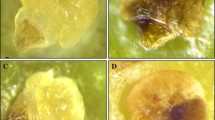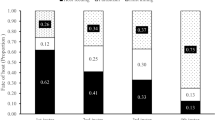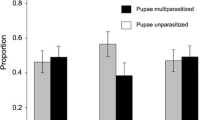Abstract
Host finding abilities were investigated in the braconid Coeloides bostrichorum and the pteromalid Rhopalicus tutela, two ectoparasitoid wasps attacking the late instar of the bark beetle Ips typographus. Under laboratory conditions, important differences in the host-searching behaviour of these species were found, R. tutela being highly mobile as compared to C. bostrichorum. In the presence of C. bostrichorum, R. tutela behaved as a cleptoparasitoid, displacing the females from their oviposition sites and stealing the hosts previously located by the braconid. This behaviour facilitated host finding in R. tutela and could partly explain the relative success of the polyphagous R. tutela when occurring with the more specialised C. bostrichorum.


Similar content being viewed by others
References
Arthur AP, Stainer JER, Turnbull AL (1964) The interaction between Orgilus obscurator (Nees) (Hymenoptera: Braconidae) and Temelucha interruptor (Grav.) (Hymenoptera: Ichneumonidae), parasites of the pine shoot moth, Rhyacionia buoliana (Schiff.) (Lepidoptera: Olethreutidae). Can Entomol 96:1030–1034
Broad GR, Quicke DLJ (2000) The adaptative significance of host location by vibrational sounding in parasitoid wasps. Proc R Soc Lond B Biol 267:2403–2409
Dahlsten DL (1982) Relationship between bark beetles and their natural enemies. In: Mitton JB, Sturgeon KB (eds) Bark beetles in North American conifers. University of Texas, Austin, pp 140–182
Eggleton P, Belshaw R (1992) Insect parasitoids: an evolutionary overview. Philos Trans R Soc Lond B Biol Sci 337:1–20
Fischer S, Samietz J, Wäckers FL, Dorn S (2001) Interaction of vibrational and visual cues in parasitoid host location. J Comp Physiol A 187:785–791
Graham MWR de V (1969) The Pteromalidae of North-Western Europe (Hymenoptera: Chalcidoidea). Bull Br Mus (Nat Hist) Entomol [Suppl] 16:412–427
Hedqvist KJ (1998) Bark-beetle enemies in Sweden. II. Braconidae (Hymenoptera). Entomol Scand [Suppl] 52:1–87
Kinn, DN, Miller MC (1981) A phloem sandwich unit for observing bark beetles, associated predators, and parasites. USDA Forest Service, Southern Forest Experiment Station, Research Note SO-269
Krüger K, Mills NJ (1990) Observations on the biology of three parasitoids of the spruce bark beetle, Ips typographus (Col., Scolytidae): Coeloides bostrychorum, Dendrosoter middendorffii (Hym., Braconidae) and Rhopalicus tutela (Hym., Pteromalidae). J Appl Entomol 110:281–291
Mills NJ (1983) The natural enemies of scolytids infesting conifer bark in Europe in relation to the biological control of Dendroctonus spp. in Canada. Biocontrol News Inform 4:305–328
Mills NJ (1991) Searching strategies and attack rates of parasitoids of the ash bark beetle (Lepersinus varius) and its relevance to biological control. Ecol Entomol 6:461–470
Mills NJ, Krüger K (1989) Host location: an important factor in the use of exotic natural enemies for the biocontrol of native scolytids. In: Paine TL, Saarenmaa H (eds) Integrated control of scolytid bark beetles. Virginia Polytechnic Institute and State University, Blackburg, Va., pp 321–328
Mills NJ, Krüger K, Schlup J (1991) Short range host location mechanisms of bark beetle parasitoids. J Appl Entomol 111:33–43
Pettersson EM (2001a) Volatile attractants for three Pteromalid parasitoids attacking concealed spruce bark beetles. Chemoecology 11:89–95
Pettersson EM (2001b) Volatile from potential hosts of Rhopalicus tutela a bark beetle parasitoid. J Chem Ecol 27:2219–2231
Pettersson EM, Hallberg E, Birgersson G (2001) Evidence for the importance of odor-perception in the parasitoid Rhopalicus tutela (Walker) (Hymenoptera: Pteromalidae). J Appl Entomol 125:293–301
Richerson JV, Borden JH (1971) Sound and vibration are not obligatory host finding stimuli for the bark beetle parasite Coeloides brunneri (Hymenoptera: Braconidae). Entomophaga 16:95–99
Richerson JV, Borden JH (1972a) Host finding behavior of Coeloides brunneri (Hymenoptera: Braconidae). Can Entomol 104:1235–1250
Richerson JV, Borden JH (1972b) Host finding by heat perception in Coeloides brunneri (Hymenoptera: Braconidae). Can Entomol 104:1877–1881
Roques A (1976) Observations sur la biologie et le comportement cleptoparasite d’Eurytoma waachtli (Chalc.: Eurytomidae), parasite de Pissodes validirostris (Col.: Curculionidae) dans les cones de pin sylvestre à Fontainebleau. Entomophaga 21:289–295
Schröder D (1974) A study of the interaction between the internal parasites of Rhyacionia buoliana (Lepidoptera: Olethreutidae). Entomophaga 19:145–171
Siegel S, Castellan J Jr (1998) Non-parametric statistics for the behavioral sciences, 2nd edn., McGraw-Hill, New York
Spradbery JP (1969) The biology of Pseudorhyssa sternata, a cleptoparasite of siricid wasps. Bull Entomol Res 59:291–297
SPSS (2001) SPSS 11.0 1 for Windows. SPSS, Chicago, Illinois
Vilhelmsen L, Isidoro N, Romani R, Basibuyuk HH, Quicke DLJ (2001) Host location and oviposition in a basal group of parasitic wasps: the subgenal organ, ovipositor apparatus and associated structures in the Orussidae (Hymenoptera, Insecta). Zoomorphology 121:63–84
Zwölfer H (1971) The structure and effect of parasite complexes attacking phytophagous host insects. In: den Boer PJ, Gradwell GR (eds) Dynamics of populations. Proceedings of the Advanced Study Institute on “Dynamics of Numbers in Populations” (Oosterbeck, 1970). Centre for Agricultural Publishing and Documentation, Wageningen, The Netherlands, pp 405–418
Acknowledgements
The authors thank Nick Mills, Jacques Pasteels, Guy Boivin and two anonymous reviewers for their valuable comments on an earlier version of the manuscript. Special thanks to Marius Gilbert and Pierre Herman for technical and field assistance. Evelyne Hougardy was supported by Fonds pour la Formation à la Recherche dans l’Industrie et dans l’Agriculture (FRIA).
Author information
Authors and Affiliations
Corresponding author
Additional information
Communicated by R.F.A. Moritz
Rights and permissions
About this article
Cite this article
Hougardy, E., Grégoire, JC. Cleptoparasitism increases the host finding ability of a polyphagous parasitoid species, Rhopalicus tutela (Hymenoptera: Pteromalidae). Behav Ecol Sociobiol 55, 184–189 (2003). https://doi.org/10.1007/s00265-003-0688-y
Received:
Accepted:
Published:
Issue Date:
DOI: https://doi.org/10.1007/s00265-003-0688-y




